
In the old days, New York City horror stories tended to involve street crime. Nowadays, many of the most chilling tales have to do with getting children into the right kindergarten. “Next year is going to be even worse,” warns Amanda Uhry, the president of Manhattan Private School Advisors, which charges $6,000 to help families get their kids into desirable private elementary schools. “It’s the post-9/11 baby boom. So many more kids were born in the city, and now they’re applying to kindergarten.” Roxana Reid of Smart City Kids adds, “Several nursery schools had ten or more children shut out from getting into school altogether last year” (and had to, gasp, resort to public schools). But is it really true that getting into a good kindergarten in New York City is as tough as getting into an Ivy League college? There’s no question that there’s a crushing demand-and-supply imbalance at the dozen or so top-tier schools, entrée to which seemingly assures future success for junior and unrivaled cachet right now for Mom and Dad. It’s true enough, too, that at those schools—Dalton, Collegiate, Trinity, Spence, Chapin, Brearley, Horace Mann, et al.—your kid’s application might not even be looked at, much less seriously considered, if you don’t submit it within the first few days after the applications are made available, around Labor Day. And since 1997, the number of kids taking the ERB (an aptitude test used by many kindergartens) to get into kindergarten has grown by almost 40 percent. More families are applying to more schools now, too—five or six was the typical number in 2000; now many families apply to nine or ten.
But in fact, the panic and excitement over kindergarten admissions is analogous to, say, half of New York trying to squeeze into the same hypertrendy restaurant on a Saturday night. Sure, you want to go, and you’d love to brag to your friends about sitting next to Michael Douglas and Catherine Zeta-Jones—who is, incidentally, planning to star in a movie about getting into an exclusive Manhattan kindergarten—but will you have a bad meal if you don’t? If you take a deep breath and realize that there are roughly 70 private schools in New York—and a growing number of great public schools, too—and that many of these, far from second choices, might even provide a better experience, you’ll discover that you can be much more in control of the process than you’d believed possible. Herewith, the strategies and tactics of getting your child into a Manhattan kindergarten.
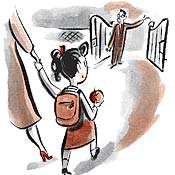
1. Who’s the most important person in the application process?
The ultimate gatekeeper is … your preschool director. “The schools review everything with the nursery-school director. ‘Is the kid really like that?’ and ‘What about the parents?’ And it’s the nursery-school director’s job to tell them,” says Victoria Goldman, author of The Manhattan Family Guide to Private Schools.
Not only must directors serve three masters—individual families, the class as a whole, and the school itself—but an awful lot can ride on how well they play the admissions game.
Even a “Baby Ivy” preschool like the 92nd Street Y sometimes places as few as 15 percent of its little graduates at the elite elementary and ongoing schools. So at pre-Ks all over the city, directors are faced with the task of deciding which deserving children are a little more deserving than the rest.
The process is called brokering, which sounds kind of evil, but in a numbers game, where a pre-K’s main objective is to avoid a shutout—a kid getting rejected everywhere—“there’s not much choice,” said one harried head of school as she took a break between parent conferences last week.
Always remember that your preschool director is not fully on your side. “Your pre-K director’s primary loyalty is to getting everyone placed somewhere, versus getting your kid placed in your ideal school,” notes Emily Glickman, an admissions consultant at Abacus. “That often places parents and directors in an adversarial position.”
One father of a boy now in first grade at a good second-tier school is still bitter when he recalls telling his son’s nursery-school director at their first admissions conference that the family had a very good connection at Dalton. She pushed them to make Dalton their first choice, but after they visited, they found that they much preferred Ethical Culture and even Calhoun over Dalton. Come January, they sent a first-choice letter to Ethical. “She didn’t say so directly, but she was clearly not pleased we didn’t make Dalton our first choice,” he says. The result: The boy was admitted to neither. “I should have kept my mouth shut until we knew which school we really wanted,” he says.
No matter how perfect you think Trinity is for your child, your nursery-school director won’t recommend your kid if she has any doubts. Linda Herman, who runs the Weekday School, acknowledges as much. “The schools have to trust me. If I send them a couple of kids who can’t cut the academics when I said they could, maybe they won’t listen so hard the next year when I recommend someone. I have to be honest.”
Well-connected preschool directors can be dictatorial when it comes to selecting schools. “Parents would come to us very upset because their nursery-school director had such strong opinions on which school their child should go to,” says Karen Quinn, a founder of Smart City Kids and the author of The Ivy Chronicles, a novel based on her clients’ and her own experiences of applying to kindergarten. “Christ Church and the Mandell School are among the five or six pre-Ks that stand out for their dictatorial ways,” says a consultant. “But at least those directors tell you to your face.”
Then there are nursery-school directors who just aren’t good at their jobs. One woman whose son applied last year initially found herself shut out in February, despite assurances from her pre-K director that she’d have no problem getting into at least one of the six schools she was wait-listed for. The director also strongly discouraged her from collecting recommendation letters from connected friends “because, she said, after the Grubman thing [an admissions scandal involving telecommunications consultant Jack Grubman and the 92nd Street Y], admissions don’t want any of that,” she says.
The best way to get your pre-K director in your corner is to lay the groundwork long before your applications are due. There’s no guarantee that your director will advocate for you over another family when Riverdale’s admissions director calls and says, “Who do I take?” But you can avoid the opposite. Volunteer, give, participate in school social events, get on a committee, and don’t make trouble.
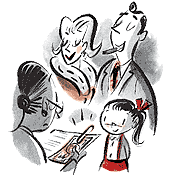
2. Will bribery work?
In a word, no. “Not only will making a big contribution to the kindergarten of your dreams not help you get in, it will hurt you,” warns Uhry. The schools don’t appreciate being treated like the maître d’ at Per Se.
And the most selective schools, finding themselves flush with both healthy endowments and negative press over preferential treatment for those who can add extra zeros to donation checks, have put out the word that money doesn’t talk like it once did.
Of course, not all schools are so loftily uninterested in money. “Look at the schools in the Bronx,” says one admissions expert. “With all those acres and buildings, they’re the size of a small college. For them, a $20 million endowment is nothing, so you better believe they’re aware of how much you can give.”
Chapin, for example, makes no bones about its expectations. “Annual Giving makes everything at Chapin possible,” it posts on its Website, listing the gap between tuition and cost ($6,900 per student and growing). The schools, however, can’t come right out and ask what you’ll give. So consider giving to your nursery school. Your pre-K director may remember your generosity at a crucial moment. “That’s definitely one of the topics of conversation, and it doesn’t have to be asked explicitly. Your pre-K director will let the school know,” says one consultant.
3. Should you despair of sending Junior to an Ivy if he doesn’t get into a top-tier kindergarten?
Contrary to popular belief, the top-tier schools are not a go–to–Ivy League–school–of–your–choice pass. Only a few of them are able to send as many as a quarter of their graduating seniors to an Ivy or Ivy Equivalent. Not bad but not extraordinary, considering the high number of kids who have an admissions edge at Ivy League schools by virtue of being legacy kids. If you go to one of the top few elementary and ongoing schools, you’re competing against some very well-connected families.
This means that “coming from schools like Spence and Dalton can actually be a disadvantage,” says Michele Hernandez, a former admissions official at Dartmouth who runs a college-admissions consulting service. “The admissions staffs at the Ivies bend over backwards not to take kids from those schools,” Hernandez contends. “Unless your kid is at or near the top at those schools, your chances of getting in from the top of a mid-level school are probably better,” she says.
It’s important to evaluate what getting your child into a top-tier school means to you. “There’s this whole mystique to getting into the ‘right’ kindergarten that goes way beyond putting your child in a school where she’ll thrive and be able to get into a good college,” says Mary Knox, a mother of a second-grader who chose to send her daughter to public school for kindergarten and first grade. “My friends thought I was crazy not to apply to private schools. It speaks to a basic human psychology of ‘Do I measure up?,’ which is magnified by ten in New York.”
4. So what are the alternatives to the top tier?
Many more schools are now worth—relatively speaking—their $25,000-plus tuitions. As it’s become harder to get into the top schools, kids who might have gotten into a Fieldston in years past are going elsewhere and lifting the levels of other schools. “There are so many more schools I’m comfortable recommending to parents as high-quality and academically ambitious than just five years ago,” says Gabriella Rowe, director of the Mandell School.
So go ahead and shoot the moon with a Dalton or Collegiate, but balance that with selections from the city’s many other high-quality schools, preferably ones that fit your kid’s—and your own—style. To find them, look for schools putting their new money to good use via new libraries and gyms, lower student-teacher ratios, and more experienced teachers, often poached from top-tier programs. Allen-Stevenson, Birch Wathen Lenox, Browning, Cathedral, Hewitt, Marymount, St. Hilda’s & St. Hugh’s, Trevor Day, Poly Prep, and Brooklyn Friends get nods as schools on their way up, as do hot schools like Bank Street and Columbia Grammar, which are receiving as many applicants as the top tier.
Fieldston Lower School often gets short shrift because most parents apply to Ethical Culture instead. Claremont Prep is only in its first year but has great facilities, and nursery-school directors say parents are giving it strong recommendations.
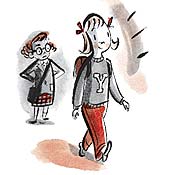
5. Is public school a viable option?
Of course, no matter how many private-school obsessives choose not to think so. The answer to this one largely comes down to three words: location, location, location. If that sounds like we’re talking real estate instead of education, well, we are. Save for the handful of non-zone schools, such as Midtown West and NEST, that accept students from the entire district or in some cases the entire city in a process much like private school, and the “test-in” programs, headlined by Hunter College Elementary and the Anderson School, and including the gifted-and-talented programs that often determine eligibility according to scores on the Stanford-Binet IQ test or similar tests, landing your child in a quality public elementary school is a real-estate play.
If you live in the Department of Education’s District 2, encompassing the Upper East Side and much of downtown, you’ve got a heckuva chance to benefit from two decades of a district administration that brought in and actively supports terrific principals who’ve hired gifted teachers from around the country, and active and wealthy parent organizations. Even a high-poverty school like P.S. 126 is considered a model of urban education and attracts middle-class families from outside its zone.
Until now, the 239 schools in the city’s gifted-and-talented programs have been administered according to a mishmash of different standards—some using IQ tests, others relying on interviews or the whim of the principals. Though deficient in many ways—many accused them of racial bias—the programs often kept kids in public school who would have gone the private-school route. But next year, schools chancellor Joel Klein is planning to apply uniform standards for gifted-and-talented students citywide, removing much of the guesswork—and loopholes—from the process.
Beyond these options, public school is a real-estate play. There are a few other schools in the city that, to certain families, might even be worth moving for. Tribeca has three great schools: P.S. 234, P.S. 89, and P.S. 150. In east midtown, the Beekman Hill School (P.S. 59) on East 57th Street rivals P.S. 183 and the schools on the Upper East Side, and is considerably smaller—always a virtue. In Park Slope, Brooklyn, the William Penn School’s (P.S. 321) main fault is that it’s too popular—and therefore somewhat overcrowded.
6. Do private-school connections still count?
One legacy dad at one of the top-tier schools who’s been a steady contributor to his alma mater figured on a sure thing when he sent in his son’s application. “I was shocked when they told us he was too young”—admissions jargon for a kid deemed not ready. “Not ready for what? The rigors of morning meeting and blocks?” His son was accepted when he reapplied the following year, “but you better believe we put a lot of work in the second time.”
Gabriella Rowe at the Mandell School sees a seismic shift in the less-than-meritocratic admissions policies. “It’s not just talk. Several schools issued directives to their boards last year that they wouldn’t accept recommendation letters from directors,” she notes.
Programs like Sacred Heart and Friends look askance at people who trumpet their connections. “The best way to turn off Barbara Root [admissions director at Sacred Heart] is to talk about who you know,” says Smart City Kids’ Quinn.
But the revolution, however, is far from complete. Schools like Trinity, Dalton, and Columbia Prep have well-earned reputations for being places where not having a strong connection can mean not getting in.
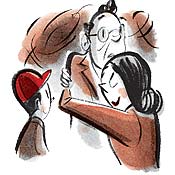
7. What are six things you shouldn’t say to the admissions officer?
“My son has a mild learning problem.” Though they don’t always like to admit it, most schools shy away from children who have issues that might affect their ability to learn or behave in the classroom. A few years ago, Riverdale’s then-director of admissions told an adviser who asked about the school’s attitude toward kids who might need extra help, “We’re not set up to deal with kids like that.”
“Let’s hang out together.” You may feel like you’ve established a rapport with the admissions director. Great, but don’t spoil it by going too far. One woman ended an interview feeling so good she hugged the admissions director. “Sometimes parents end up feeling so comfortable in their interview, they reveal problems that could raise flags,” Quinn says.
Don’t ask probing, and possibly sensitive, questions. “The proportion of teachers with advanced degrees is an indicator of a school’s commitment to academic excellence,” Rowe says. “But it’s challenging to ask about it at the interview.”
Avoid bragging of any kind, and don’t make any claims for your child unless you can absolutely, positively back them up. One Upper East Sider exaggerated his son’s viola playing, claiming the boy was a virtuoso on an application essay. The school asked him to bring it to the interview to hear his son play. Words like gifted, fantastic, and terrific can sound great coming from a nursery-school director, but from a parent they sound like the crassest hyperbole. If you think your daughter’s a genius, work it into an anecdote about how she’s been crazy about math since she was 2.
Don’t sound rehearsed. “I get the sense of talking to more parents who’ve been prepped for interviews, and it’s a big turnoff for me,” says Ronnie Jankoff, Allen-Stevenson’s admissions director. “I want to get to know the parents, not have people who are coached.” In other words, “admissions officers have astute bullshit monitors,” says one pre-K director.
“And for God’s sake, don’t mention money,” advises Uhry.
8. What’s the best way to talk to an admissions officer?
Ask questions that relate to what each school cares about. For example, Friends cares a lot about creating a community and about community service. You should refer to that in your conversation. Bank Street, which has mixed-age classes, is very concerned that the kindergartners it enrolls can hold their own with the older first-graders. Be prepared to tell stories illustrating how mature little Todd or Sarah is.
And be genuine. That means not showing up for an interview at Sacred Heart wearing Chanel and talking about how important diversity is to you. If you like going to the ballet more than working at a soup kitchen, say so, but shape it positively. Ask questions that relate to your interests: “Is there a dance group, because our family really enjoys going to ballets on weekends.”
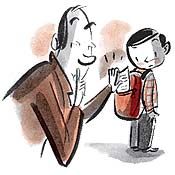
9. Should I prep my kid?
The prevailing wisdom states that not only is it unhelpful and wrong to try to give your precious little one a leg up on his classmates, but it’ll come back to bite you where it hurts. Playgrounds are rife with stories of 4-year-olds blurting out, “I’ve done this before,” at the test. ERB testers, everyone warns, are trained to spot kids who’ve been prepped, and admissions directors are on the lookout for children whose test scores don’t match up with the teachers’ reports.
But the fact is, pre-K intelligence tests are notoriously unreliable measures of intelligence—studies show that who conducts the test and where it takes place can alter performance, scores can swing wildly on retesting, and practicing can result in significant increases in performance. What’s more, lots of people prep for the test. “We interviewed 200 families who just completed the application process, and over half reported doing some level of preparation,” says Quinn.
Child experts, from psychologists to educators, warn against outright coaching but say there’s nothing wrong with helping your daughter work on the skills she’ll need to use on the ERBs. “The abilities tested—pattern recognition, comprehension, vocabulary—are skills parents should be stimulating in their children from the time they open their eyes,” says Dr. Chris Lucas of NYU’s Child Study Center.
In other words, there’s prepping, and there’s Prepping.
The same logic applies for the school interview. “Giving your child advance exposure to the kinds of things he’ll be doing or asked in the interviews is perfectly fine, as long as it’s done gently and with your support and assurance,” Dr. Lucas says.
Though most schools won’t hold it against you if you promise your kid an ice cream afterward for playing nice, they don’t take kindly to advising your kid not to tell anyone about it. “That’s a very negative comment on the parent, and we certainly do take note of it if we find out,” says one admissions officer.
A few preparation options that won’t raise red flags: For the tests, get professional help from educational consultants like Sheila Harris, who suggests games, books, and other materials parents can use to help their children develop learning skills, or Roxana Reid, an educational social worker who runs Smart City Kids, and who identifies areas in which children can improve skills that are used in the test and help with the preparation.
Test in the spring. “Kids are often more focused and comfortable in a test setting after nine months of school than when they’ve been off playing for three months over the summer,” notes Reid. New friends, new teachers, and the fall virus season can all result in lower test scores. Also, in the spring the field is smaller and competition lighter because fewer parents think of doing it six months early.
For the interview, let your child know what he’ll be doing. Is it a one-on-one with a teacher, a playgroup, or a combination? Talk about the interview in a positive light. And practice: Arrange show-and-tells with kids he doesn’t know, and have your child speak to unfamiliar adults, first with you present, then without you.

10. What’s the best way to sway a school?
“We always like to know if a family loves us,” says Allen-Stevenson’s Ronnie Jankoff. And nothing says love better than a first-choice letter, the note most families, after much hand-wringing over which to choose, send to the school to which they’d either most like to gain entry, or think they have the best chances of doing so—many times a combination of or compromise between the two. “Even though many schools don’t ask for a first-choice letter, it’s a show of real enthusiasm for and commitment to a particular school, which makes it easier for me to pitch a child to that school,” says Linda Herman, director of the Weekday School.
Why, you may well ask, if so many schools are deluged with applications, should an admissions director care so much whether you tell them that of the eight, or ten, or fifteen schools you applied to, hers is the one you’d most like to send your child to?
The answer lies in the yield—the percentage of families who actually accept a school’s invitation to join their community. It’s a more important number to the admissions department than how many applications it receives. “Admissions directors have to report to boards of directors, and one of the key figures they’re judged on is their yield,” says author Victoria Goldman. In a time when boasting an acceptance rate lower than an Ivy League college inspires yawns, a yield nudging 100 percent is a cause for celebration. “It’s the ultimate indicator of a school’s appeal and the admissions director’s skill,” says Hernandez.
Most schools in the top tier reap yields in the high eighties or nineties. Take 10 to 20 percent for the next rung. “Spence,” says one admissions expert, “supposedly had a 100 percent yield last year.”
Game your choice wisely, because you’ve got only one in your quiver. Some schools just file the letters away; others outright don’t want them. Admissions advisers mentioned Collegiate and Bank Street among the schools that fit into those categories. On the flip side, Trinity, Friends Seminary, and all the girls’ schools except Brearley are said to value them. Schools such as Hewitt and Packer, both making strong efforts to rise into the upper echelons, are also good candidates.
Finally, you may have to use your own judgment, based on the feel you get from touring and interviewing at the schools you liked the most: Do your child’s style and academic inclinations match up with what the school seems to be looking for? And should you send your first-choice letter to the school you like most where you also think you have the best chance of getting into, or the one you most desire? Which strategy you choose often comes down to your attitude toward risk.
11. What if I get shut out?
It doesn’t happen often, despite what the gossip on urbanbaby.com’s New York schools online forum would have you believe, but it happens: “I always get a bunch of calls on February 15 from parents who didn’t get in anywhere,” says Uhry. “It’s what I like to call the start of the second season of the admissions process.”
It may seem like the end of the world, but there are always options. First, get on the phone to all the schools you didn’t end up applying to. “There are always schools that still have openings,” says Uhry. “It’s a matter of talking to admissions directors to see who’s got what.”
Many pre-Ks take kids for an extra year of nursery school, especially when their birthdays run into the second half of the year. Schools like the vaunted 92nd Street Y and the Weekday School often have spaces because so many kids leave for kindergarten at K-8 schools. “Having that extra year with us to mature and do more academic work has been very successful with families that come to us for kindergarten, in terms of placement at elementary schools,” says Linda Herman, director of the Weekday School. “The selective schools like having a child who’s had that extra year of seasoning,” she says.
One downtown mother found that applying after the kindergarten crush was a much easier process. “Instead of 500 applicants, we were one of ten, applying for two spots. It was a much calmer feel,” she says. Her daughter applied to four schools and was accepted at two.
And a mom on the Upper West Side who’s applying for a second time at Trinity this year says, “I know the admissions person now. She’s very sympathetic. I get the feeling she’s pulling for me, because she knows how much I want to get in.”